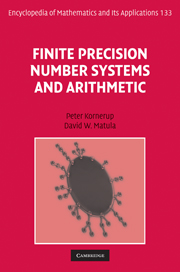9 - Rational arithmetic
Published online by Cambridge University Press: 05 March 2013
Summary
Introduction
This chapter presents a detailed introduction to various finite precision representations of rational numbers and associated arithmetic. It is the result of more than a decade of collaborative research by the authors, and as such has not so far been given a cohesive presentation, but has only been available in a sequence of conference presentations and journal papers. These representations are well founded in classical mathematics (number theory), and many problems are naturally stated in and computed in the domain of rationals. Such problems can be solved exactly in systems based on unbounded integer representations, and possibly also in residue representations as discussed in the previous chapter. However, in many cases an approximate solution based on a finite representation may be sufficient.
The first class of representations is based on the traditional way of using pairs of integers of bounded size. Two natural bounds are proposed: the first simply applying a common bound on the values of numerator and denominator, the other a bound on the product of these. The latter representation will allow a larger range of representable rational values, but for practical reasons it will be approximated by bounding the total number of digits (bits) employed for representing the numerator and denominator using radix polynomials.
It is essential in all such finite representation systems to have an associated rounding rule which allows the mapping of any value from the underlying infinite mathematical domain into the chosen finite set of representable values.
- Type
- Chapter
- Information
- Finite Precision Number Systems and Arithmetic , pp. 633 - 690Publisher: Cambridge University PressPrint publication year: 2010

